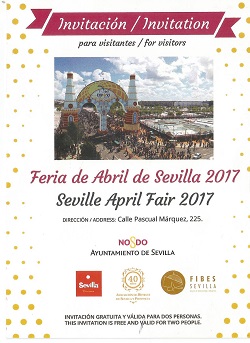Tourist caseta at the Feria de Abril in Seville

This year's Feria portada (gateway) celebrates the 25th anniversary of Expo 92, and the Murillo 400th Anniversary too.
What is a caseta?
A caseta is a tent, usually small, and green- or red-and-white striped; more than 1,000 of them line the sandy pavements of the recinto (fairground) in Los Remedios, to the south-west of the city centre. They're the heart of the Feria, where Sevillanos eat, drink, talk and dance; tables and chairs in the front part, decorated individually by each caseta's group, and the bar at the back - where you'll often find the liveliest atmosphere.
At the Seville Fair, unlike others around Andalucia, most casetas are private, and you can only enter if invited. This means it is virtually impossible for tourists to experience, as they're unlikely to have an "in". The smaller ones are generally owned by families, groups of friends, or associations - these make up the vast majority. Larger tents, more like marquees, are either owned by private companies, trade unions, political parties or the city council, which has free-entry casetas for each city barrio, so that the citizens of Triana, Macarena et al can enjoy their jamon, rebujito (sherry and lemonade) and Sevillana dancing without the expense of hiring a caseta.

A group of feriantes at the Feria de Abril in Sevilla.
With the limited space of the recinto - it is not small, with 13 streets and 240,000m2, but many feel the Feria needs a larger area - there is always a long waiting list for casetas at the Feria, and many groups have been hoping to secure their own base for years. So the decision by the Ayuntamiento (city hall) to use a large caseta, previously rented by Abengoa, the troubled Seville-based multinational sustainable energy company, for tourists, was controversial.

Invitation to the tourist caseta at Sevilla's Feria de Abril 2017.
The tourist caseta
In 2017, the city hall distributed 30,000 of these invitations around Seville's hotels, to let tourists know that there's a caseta at the Feria where they will be welcome. The address of the caseta is Pascual Marquez 225-229, at the furthest point from the main entrance, near Calle de Infierno funfair. It's also close to three free-entry public casetas.
This caseta is also public, but its purpose is firmly focussed on making tourists at the Fair feel welcome at what can be a huge and bewildering event. Staff from the Seville Tourism office will be on hand to explain and answer questions, from 12.30 to 7.30pm, in English, French and German; menus will also be available in these three languages. The caseta accommodates 400 people, so there is a lively atmosphere, and there are live music performances.
Free tours of the Feria
The QR code shown on the invitation links to Google Maps, so tourists can easily find their way to the caseta using their mobile phones - perhaps more useful than the somewhat minimal plan on the invitation.

Simple map to show where the tourists' caseta is located. The QR code links to Google Map's
As well as some Sevillanos feeling that locals should have had priority for a much-sought-after vacant lot, I've read comments on news websites about a perceived danger of the Feria becoming simply a tourist attraction, and adding that this hallowed event should be exclusively for Sevillanos. Sadly, that attitude is fairly prevalent among certain sectors of Sevillano society, although whether one caseta could change the fair's atmosphere to such an extreme extent remains to be seen.